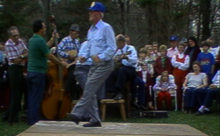Mike Seeger Introduction to "Talking Feet"
I have been trying for a long time to get someone to film a documentary of solo Southern dancing. Mountain dancing possesses great freedom and exuberance and is a natural outgrowth of, and companion to, the music I love so well. But unlike traditional music, traditional Southern dancing has not been documented prior to this project. In my opinion, it was simply too expensive and cumbersome to take camera and recorder into the field and then to edit the material.
I wish I could have had a video recorder with me down through the years, along with my tape recorder. I would have recorded Elizabeth Cotten dancing the "Frisco" or "Ball the Jack." Or "Junior," Hazel Dickens' cousin, doing a moonwalk-like slide as we played bluegrass in a basement apartment in Baltimore. Or Don Reno in the 1950s, when he took a frenetic, stepping break in his New River Ranch performance of the classic bluegrass instrumental "Rawhide." Or at that same country music park, Kentucky Slim (with Flatt and Scruggs) and Chick Stripling (with Bill Monroe) as they did their minstrel/vaudeville dances and routines, barely out of the black-face era. I would have filmed the Blue Ridge Mountain Dancers, who in the early 1960s were performing some of the first precision clogging, which was, in a sense, a complement to bluegrass: an ensemble stage presentation based on solo homestyle traditions. I would like for you to have seen Cousin Emmy in her sixties, doing a Kentucky buck dance, only to be upstaged by 250-pound Cajun accordionist Cyprian Landraneau, also in his sixties, who "limped" out on stage and let fly some vigorous Louisiana stepping. I wouldn't have been able to film an occasion at a Manassas, Virginia, bluegrass tavern, when a huge fight broke out after a waitress tried unsuccessfully to stop a man from dancing a few good-natured steps near his table. (The music and dance stopped, but the fight continued outside. I guess some non-dancers have a different physical response to music.) I would have certainly spent days filming my favorite old-time North Carolina dancer, Bill McElreath, back in the sixties, with his variety of styles and multitude of steps. It seems wherever I've gone that there is country string music-homes, taverns and country music parks-dancing has always been there.
Traditional Southern dancing has been virtually ignored by makers of documentary films and is treated lightly by TV, which generally shows only brief shots of dancers and focuses more on dress than on body movement. It is significant that this is the first document of Southern dance, when there are scores of films dealing with music, crafts and other folklife subjects.
Solo mountain-style dancing is a vital expressive companion to traditional music. Like music-making, it can require time, thought and effort to learn, such learning usually being part of enjoyable social gatherings. Unlike the making of string music, dancing is both rhythm-making and body movement.
Mountain dancing has many things in common with traditional ballad singing, solo fiddling and banjo picking. They were all part of the same everyday life, and existed side by side in the same time and place. They are usually subtle and style is always personal. Dancers, singers and musicians all learned from, entertained and danced with family and nearby community members. Although some dancers may speak a similar basic body language, each has their own brogue, that is, their own style, with moves that differ in varying degrees from those of other dancers. Unlike contemporary music-making, dancing is only now beginning to be formalized, commercialized and homogenized, largely through TV and organized clogging groups. Fortunately, there are still many dancers, especially those over fifty, who learned within their local communities and retain their own styles.
This project is the first attempt to visually document the repertories of traditional dancers from the southeastern mountains. The area we have covered is fairly limited: from southern West Virginia to western North Carolina, with a couple of journeys outside of the mountains, into the North Carolina Piedmont, and to explore the spread of Southern dancing into other areas of the United States. This is a presentation of dancing as much as one about dancing; it is a survey on the basis of region, approach, style, gender, age and cultural origin. Our aim is to document the dances and to help young dancers and enthusiasts become familiar with the older, more traditional styles of dancing that they would not otherwise see, much as sound recordings have helped young musicians become familiar with older, more traditional styles of music.
Our editing and organization of this videotape is much like an audio recording. We include many complete performances, organized in segments focusing on one person or community. In our preparation, we encouraged our dancers to include as many steps as possible and to talk with us about their dancing. A great deal of information is contained in the book Talking Feet, mostly taken from our recordings.
